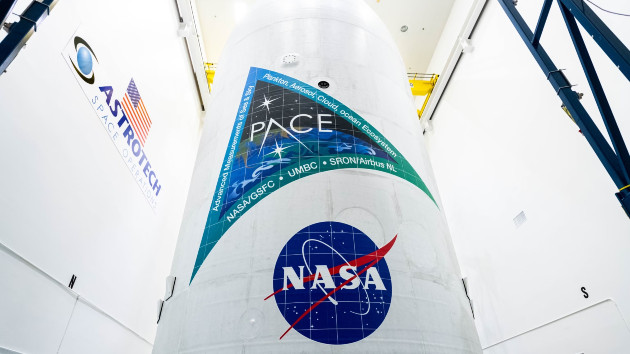(NEW YORK) — While NASA is known for observing and researching outer space, the agency is also using a spacecraft to explore a frontier here on Earth — the world’s oceanic and atmospheric mysteries.
NASA’s PACE spacecraft is set to launch with a SpaceX Falcon 9 rocket from Florida’s Cape Canaveral Space Force Station on Thursday at 1:33 a.m., local time after being delayed from a Wednesday launch, according to the agency.
NASA and SpaceX announced they are “standing down” from the mission “due to ground winds preventing prelaunch checkouts,” the agency said in an update Tuesday.
PACE stands for Plankton, Aerosol, Cloud, ocean Ecosystem and the spacecraft will be used “to collect data on clouds, aerosols and phytoplankton growth that can determine ocean color,” according to NASA’s Feb. 1 press release.
“Measuring the color and amount of light will help scientists better understand the types and locations of microscopic algae, which are vital to the health of Earth’s oceans and its marine life,” the agency said. “PACE will contribute to NASA’s more than 20 years of global satellite observations of ocean biology and key measurements related to air quality and climate.”
NASA says the data from PACE will help to better understand the exchange of carbon dioxide between the ocean and the atmosphere as well as how aerosols could possibly fuel phytoplankton growth on the ocean’s surface.
After its launch, the 10.5-foot-long spacecraft is designed to reach a 676.5 km (420 mi) orbital altitude with a 98-degree inclination, according to NASA. The agency hopes PACE will orbit and collect data for three years.
NASA reports that PACE will use three instruments:
- The Ocean Color Instrument (OCI) will measure properties of light over portions of the electromagnetic spectrum to analyze ocean color data records for climate studies.
- The Spectro-polarimeter for Planetary Exploration (SPEXone) will facilitate accurate characterization of aerosols in the atmosphere by measuring sunlight reflected back from Earth’s atmosphere, land surface, and ocean.
- The Hyper-Angular Rainbow Polarimeter (HARP2) will measure aerosol particles and clouds, as well as properties of land and water surfaces.
“This is a wonderful mission that is going to tell us about the health of our oceans and the quality of the air that we breathe,” Nicky Fox, head of science at NASA told ABC Chicago station WLS-TV.
“I’m just excited about the new way we’re going to be looking at our planet,” Fox continued.
“We’re going to be looking at the ocean with unprecedented detail — if you think about looking at a prism, it looks like a piece of glass. But if you shine a light through it, you spread that out into all the colors of the rainbow and that is essentially what we are doing with PACE,” Fox said. “We are sort of shining a light on the Earth’s water system and allowing us to look at them in unprecedented detail all the way from ultraviolet up to near infrared so not just looking at the fact that we have phytoplankton in the ocean, but actually to be able to look at the different species, some of which actually can be harmful for us.”
Copyright © 2024, ABC Audio. All rights reserved.












